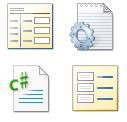Let's focus on the Data Access Objects. These classes contain the methods for CRUD
("Create, Read, Update, Delete") actions on a specific Entity class.
BLD has created your Data Access Object from the base class PeterBlum.DES.EntityDAO.BaseEntityDAO
<EntityType>. BaseEntityDAO and its subclasses are called
BLD DataAccessObjects. BLD DataAccessObjects provide
advanced features such as caching, paging, and work with the User Interface's filtering controls.
As you look through the files that were generated, you will
see classes like CategoryDAO and ProductDAO. These are your Data Access Objects.
BLD DataAccessObjects already know how to interact
with LINQ to SQL, Entity Framework or whichever data acccess technology that you have chosen,
but do so in a generic way. For example, their Update method does not use stored procedures,
as those are specific to your application. Now is the time to customize their Update,
Insert, and Delete methods to conform to your business logic.
In the code file Order.cs shown in the Source Code Browser, you will see sample methods.
They assign a value to the Order's CustomerID property before letting the ancestor
to the rest. In your own code, you could call a stored procedure,
prepare the Entity instance differently or write data differently
from the base class. However, you do not write validation code here. Validation
has already occurred prior to calling these methods.
protected override void Update(LINQtoSQLEntityDAO<Order>.L2SChangeEntityActionWrapper pWrapper)
{
Order order = pWrapper.GetEntity();
if (order.Customer != null)
order.CustomerID = order.Customer.CustomerID;
base.Update(pWrapper);
}
protected override void Insert(LINQtoSQLEntityDAO<Order>.L2SChangeEntityActionWrapper pWrapper)
{
Order order = pWrapper.GetEntity();
if (order.Customer != null)
order.CustomerID = order.Customer.CustomerID;
base.Insert(pWrapper);
}
Your Data Access Object should provide methods that return
a list of Entities matching a query. In BLD, we call these
Select methods.
BLD DataAccessObjects already have some generic Select methods.
- Select() – Follows the filters and sort keys passed in. Handles any query developed by the consumer of your Data Access Object.
- SelectAll() – Returns all Entity objects. Follows the sort keys passed in.
- SelectOne() – Pass in the unique ID of a record and it returns that record.
- MultiFieldTextSearch() – Show all records that match text to find and the list of DataFields with their FilterAttribute.InMultiFieldSearch set to true.
The Select() and SelectOne() methods are automatically used by BLD's Page Templates, so its important
that they conform to your database. SelectOne() as designed only takes a single primary key. The Order Details
table has two primary keys. So the Order_Details Entity class implements a custom SelectOne() method
as shown in the code file Order Details.cs in the Source Code Browser.
[DataObjectMethod(DataObjectMethodType.Select)]
[SelectArgs(Filters=false, SortExpression=false, Paging=false)]
[SelectMethodParameter(ActualName="orderID", AliasNames="Order",
Description="The primary key to a record in the Orders table.")]
[SelectMethodParameter(ActualName="productID", AliasNames="Product",
Description="The primary key to a record in the Products table.")]
public IEnumerable<Order_Detail> SelectOne(int orderID, int productID, SelectArgs args)
{
args.AddEntityFilter(new CompareToValueEntityFilter("OrderID", DES.ConditionOperator.Equal, orderID));
args.AddEntityFilter(new CompareToValueEntityFilter("ProductID", DES.ConditionOperator.Equal, productID));
return ExecuteSelectCommand(args);
}
Your application is likely to need other queries for which you can add Select methods.
You don't have to add every case. The UI is able to create filter objects, called EntityFilters,
which they pass to the Select methods within the SelectArgs parameter, allowing them to narrow the scope even further.
The SelectArgs parameter is found on any of these Select methods, and provides all kinds of information
for your method to consume (or ignore). That includes the EntityFilters, the Sort expression,
if paging is supported, and caching rules. It also contains tools for your Select method to communicate
its own requirements with the BLD query engine within the Data Access Object.
Below are a few examples of Select methods to support Product entities. You will find these
in the ProductDAO class of Product.cs file to the right.
[DataObjectMethod(DataObjectMethodType.Select, false)]
[SelectMethodParameter(ActualName="startPrice", AliasNames="StartPrice")]
[SelectMethodParameter(ActualName="endPrice", AliasNames="EndPrice")]
[Description("All Products whose UnitPrice is within these parameters.")]
[SelectArgs(Filters=true, SortExpression=true, Paging=true)]
public IEnumerable<Product> SelectPriceRange(
decimal startPrice, decimal endPrice, SelectArgs selectArgs)
{
if (endPrice == 0)
endPrice = 999999999.99M;
selectArgs.EntityFilters.Add(
new RangeEntityFilter("UnitPrice", startPrice, endPrice));
return ExecuteSelectCommand(selectArgs);
}
[DataObjectMethod(DataObjectMethodType.Select, false)]
[SelectMethodParameter(ActualName="startPrice", AliasNames="StartPrice")]
[SelectMethodParameter(ActualName="endPrice", AliasNames="EndPrice")]
[Description("All Products whose UnitPrice is within these parameters.")]
[SelectArgs(Filters=true, SortExpression=true, Paging=true)]
public IEnumerable<Product> TopTen(SelectArgs selectArgs)
{
NorthWindDataContext vDataContext = new NorthWindDataContext();
var vProducts = vDataContext.Ten_Most_Expensive_Products();
return ExecuteSelectCommand(vProducts, selectArgs, "TenMostExpensive");
}
In the next topic, you will
explore the EntityFilters that are used in your Select methods and many other places.

Open the Source Code Browser (C# only)